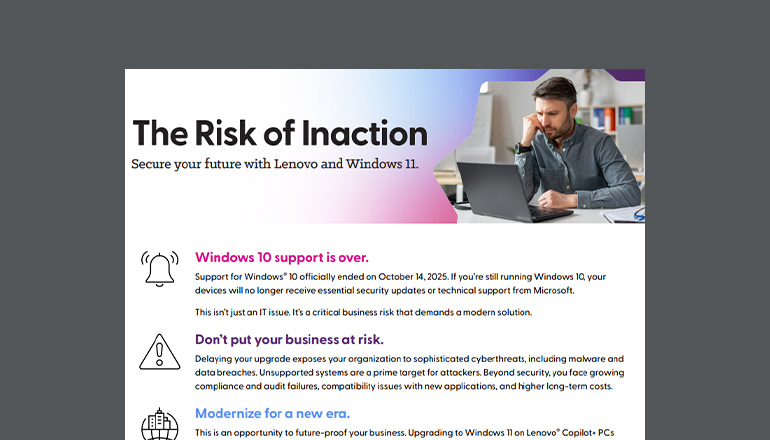Blog 10 Tips for Working From Home
Working from home offers many advantages for employees – from scheduling flexibility and reduced costs, to time savings and improved career options. It also has benefits for organizations, including reduced overhead costs, increased productivity and access to a wider talent pool.
By Jill Blasey-Ciociola / 27 Mar 2020 / Topics: Modern workplace Hybrid workforce Mobility Digital transformation

Over the years, my team and I have helped dozens of organizations adjust to shifting workplace dynamics, including adopting a virtual workforce and the technologies required to support it. We’ve found embracing the right mindset and clearly communicating expectations are key to successfully working from home.
To help you and your team get started, here are a few helpful tips for working from home to encourage employees to remain productive, engaged and mentally fresh while working remotely.
1. Create a workspace.
Whether it’s a whole room in the house, or just a desk in a corner, you’ll want to begin by establishing a permanent workspace as your home office. Don’t use this space for anything else, and don’t share it with others. This will help to ensure that you have professional surroundings to keep you focused and that your business tools will always be where you need them. Avoid working from a table that must be cleared for meals daily; an inexpensive folding table that can serve as a dedicated desk is a much better option.
When establishing your office, remember that video calls through Skype and Teams are becoming more common, so you may want to consider the lighting and backdrop in your office space. Place a test call to make sure your background represents you and your organization well. While it’s OK that people know you work from home, you’ll want to keep distractions to a minimum and avoid anything that could be controversial.
Pro tip: Many videoconferencing platforms now offer a “blur background” feature. Put it to use on days when kids might be home or if you’ve forgotten to put away your laundry.
2. Establish regular work or study hours.
If you were expected to follow defined work hours when you were traveling to an office, your home office should be no different. Schedule your time as if you’re clocking in and out, updating your calendar and messaging platforms accordingly to let people know when you’ll be available.
A set work schedule also means stopping at a designated time. It’s easy to keep working late into every evening, but consistently working more than eight hours a day will make you less productive over time. There will always be occasional days that require extra hours but a fixed stop time allows your mind and body to know when to relax.
If you are managing kids at home, try scheduling a five- to 10-minute block at the bottom of every hour to check in and get them started on their next project or activity. This allows you to join meetings on time at the top of the hour.
Pro tip: Pro tip: Set daily alarms on your phone or computer to mark breaks, lunch and the end of your shift.
3. Dress for success.
Getting dressed for work is a great way to get into a “work” mindset. Looking professional helps you feel professional and stay productive throughout your day. Set your alarm, get up and take a shower, and get dressed as if you were going out to see people — even if you have no plans to do so. This doesn’t mean you have to dress like a banker — business casual is more than enough to mentally put you into “work mode.” But if your CEO sends you a video chat unexpectedly, you’ll be prepared to answer the call wearing something other than a hoodie.
Pro tip: If no one is going to see your feet, feel free to skip the heels and wingtips and pair that outfit with some bunny slippers.
4. Avoid digital distractions.
With no one peering over your shoulder it can be easy to get lost down the rabbit hole of online news, social media or the latest binge-worthy TV. But when working from home, make every effort to treat your workday as just that: a workday.
Don’t work in front of the television; the sound of sports or talk shows can easily pull you in, killing productivity. If you prefer to work with some background noise, try listening to soft music or use a white-noise machine. Avoid distractions like streaming services and YouTube, so you can focus on getting things done.
Pro tip: Maintain a to-do list and daily schedule to help keep your work on track.
5. Eat healthily.
Working from home means working near the kitchen, which can make it tempting to graze on snacks all day. (After all, no one’s going to see you finish off that pint of Ben & Jerry’s, right?) Without the structured limitations of a standard working environment, you’ll want to make a conscious effort to maintain healthy eating habits. Plan your meals as if you were heading to the office. Pack your lunch the night before and treat snacks as you would if you had to buy them from the vending machine — sparingly. Sticking to healthy foods and regular routines will give you the energy you need to stay productive and help you avoid the “work-from-home 10.”
Pro tip: Stock up on dried fruits and limited-calorie packs for quick snacks.
6. Avoid interruptions.
Few people who work from home actually have the house to themselves. Spouses, roommates, children and pets who share the space can — and will — become a distraction or interrupt while you’re on an important call. Work with your family, friends and neighbors ahead of time to develop a system indicating when you need quiet or when you’re not to be disturbed. Post a sign on your door or leave a light on in the hall to remind others of your schedule. This will help to keep your background clear of passersby and other distractions during office hours.
Pro tip: Schedule frequent small breaks during the day to check on kids and pets to ensure they’re otherwise occupied while you’re working.
7. Take breaks.
Taking breaks to stand, stretch, walk around and drink of water can help relieve neck and eye strain as well as back and leg fatigue. Taking a lunch break away from your home office for a short time gives you a natural break that will help you feel connected with the rest of the world. Climb the stairs or do calisthenics to keep the blood flowing.
Be mindful when scheduling appointments or running errands during the day. Longer periods of absence should be scheduled the same way they would be if you were in the office so that managers and coworkers know when you’ll be unavailable. If daytime activities run longer than expected, it can easily push your work into the evening and throw off your rhythm for the week.
Pro tip: Schedule appointments in compliance with company policy and block out the time well in advance.
8. Communicate expectations.
Working from home is an adjustment for those around you as well, including kids, pets and neighbors. Communicate expectations about your work hours, noise, interruptions and distractions upfront to ensure that everyone respects your workspace. Just because you’re working from home doesn’t mean you’re “at home” during working hours.
The reverse is true for your colleagues as well. Be clear that while your office is at home, you’re still working during business hours. Demonstrate that you can do your job as effectively as you always have but be sure to disconnect at the end of the day to allow yourself to simply be “at home.”
Pro tip: Post a note on your door to let others know when you’re on a call and need quiet.
9. Get in some face time.
Get comfortable with video calls. Speaking face-to-face with coworkers and customers helps create important connections with the other party and reinforces the fact that despite being at home, you’re at work. Whether you prefer Teams, Skype or Google Hangouts, get in the habit of reaching out through video chat rather than sending an email. Schedule internal and external meetings to take advantage of the face-to-face interaction and team building offered by video conferencing.
For the young ones, Facebook Messenger offers a chat and video chat function that is invitation-only, allowing your kids to interact with their friends and classmates safely. Try scheduling play dates with other parents or have them connect while working though lessons or activities online.
Pro tip: When scheduling a meeting, mention your preference for video conferencing so that others will be prepared.
10. Enjoy the advantages.
Treating your home office like any other office will keep you focused and productive, but there are plenty of advantages to working from home that you can still take advantage of.
Try sorting the laundry first thing in the morning so you can run loads throughout the day. The end-of-cycle buzzer is a natural way to encourage yourself to take a break and stretch your legs. Enjoy a change of scenery by working on the porch or taking calls in the yard while catching some rays. Use your lunch break to take a walk with your dog or surprise your spouse with a visit. Sign for packages when they arrive or order takeout and have dinner on the table when the family gets home.
Pro tip: Finding a well-balanced routine that maximizes the benefits of working from home can take some time. Keep making adjustments until you find what works for you!




